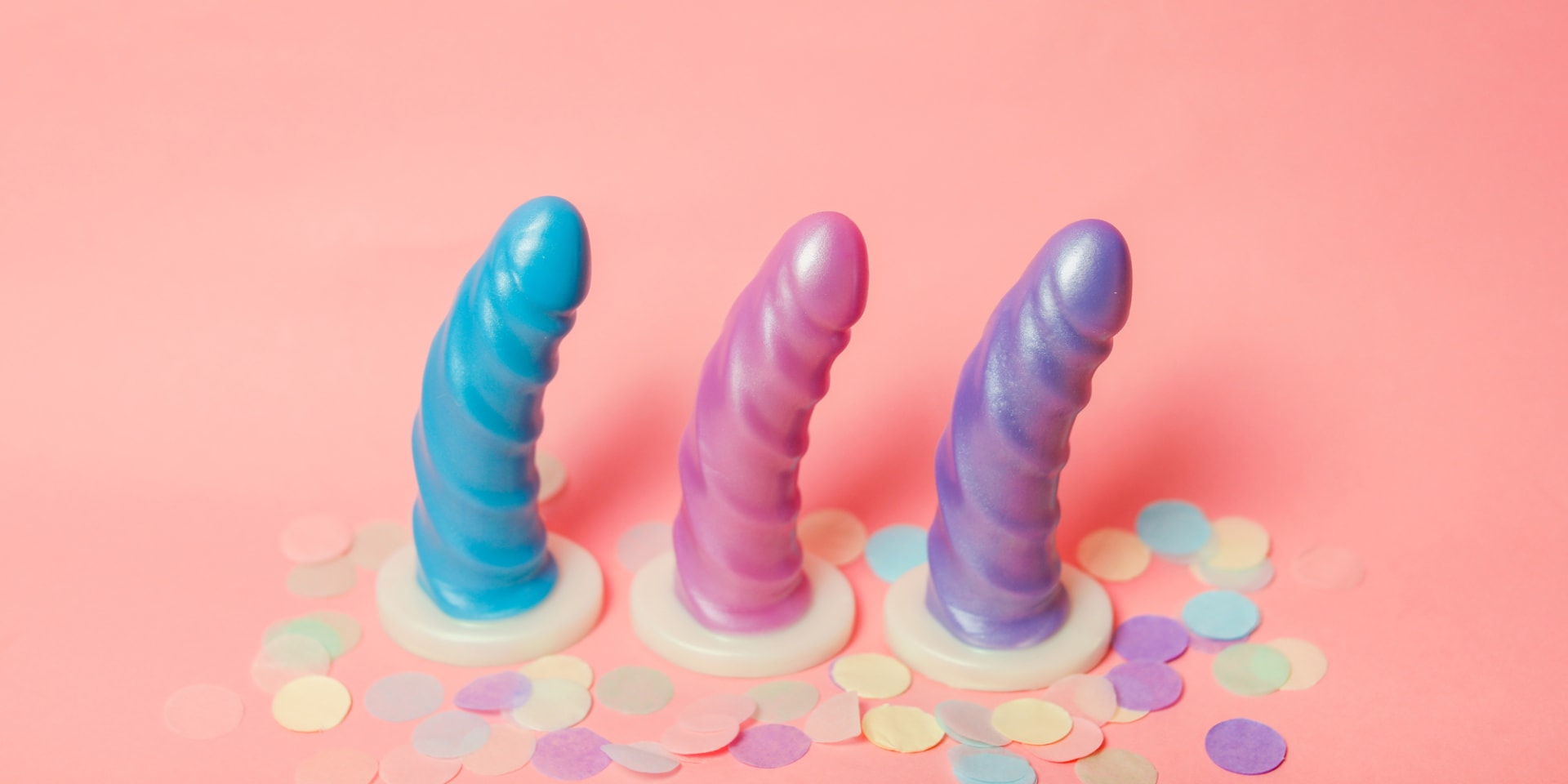Exploring the World of Dildos: Shapes, Sizes, and Materials
What is a dildo?
A dildo is a sex toy designed for penetration and (potentially) an intercourse-like experience. (Not everyone will think of dildo play in those terms though.) Dildos come in a wide range of shapes and sizes; we will get more specific about these below. Read on to learn more about this popular toy type and consider if it’s something you and/or a partner would like to explore. These are great sex toys for women–and everybody else!
The difference between a dildo and a vibrator
Very simply, vibrators vibrate, and dildos (largely) do not. There are exceptions to that rule, because a dildo can be designed with a hollow core to hold a vibrator. Insertable vibrators, when their power is turned off, can work just like a dildo.
Though they can function similarly, vibrators and dildos can’t be considered as interchangeable; some vibrators are not made in a shape useful (or safe) for penetration, and dildos and vibes stimulate differently when used as designed. Vibration is especially effective on and around the clitoris and penis (especially the head), the anus, nipples, and other parts of the body that are especially sensitive to touch–and vibration itself specifically stimulates certain nerve endings. Yes, some nerves are extra tuned-in to the sensation of vibration! And the nerves that dildos stimulate during vaginal or anal penetration are largely those that carry the sensations of pressure, motion, and fullness–all the things dildos do so well!
The different functions of a dildo & how they can affect stimulation
Continuing from the above info about nerves: This helps us understand why dildos are especially useful for insertion play. And an insertable vibe will stimulate those nerves too, but its most powerful ability to sexually stimulate its user will probably be with external vibration.
The vagina, especially, does not have as many nerves inside that respond to vibration–which can confuse a new vibe user who assumes all sex toy use should essentially mimic intercourse. There are many other ways to enjoy stimulation! This doesn’t mean that a vibe user should not use their toy for internal play, if it is shaped properly to safely do that. But it does mean a person especially into penetration might not care if their toy vibrates when they engage in the penetration they enjoy!
Dildos can stimulate whether they are large or smaller, straight or curved, realistic-looking or not, but many users will have specific preferences regarding size, shape, and other effects. These might have to do with aesthetic choices or sexual fantasy, but also might be primarily about stimulating in a certain way. A straight dildo won’t give as much stimulation to the g-spot or prostate as a curved one; a slender dildo won’t activate stretch receptors as much as a girthier one. But we all have different preferences, so it’s worth thinking about what kind of stimulation would be right for you.
Vibrating dildos
As mentioned, a dildo can vibrate, if it is designed to be fitted with a vibrator (many can be removed, while others are a permanent part of the design and you can use the vibrating function when you want, or just add it sometimes). Since many people like to use a vibrating toy on their clitoris or penis while using a dildo vaginally or anally–a great way to achieve a blended orgasm–one vibrating dildo likely won’t do both things at the same time. So some toy shoppers choose to get a dildo and a vibrator.
You can also slip a vibrating cock ring onto a dildo that isn’t equipped for vibration if you want to add more sensation of this kind.
Thrusting dildos
A special category of insertable toy is the thruster, which moves on its own, once you switch it on, to thrust in and out. These can often be used at different speeds, which changes the intensity level of the experience. You will probably have to stabilize the toy with one hand even after you guide it into your body part of choice, and when you pick a thrusting dildo, make sure you like the size and shape, as these will be a big part of the experience of using it. Here’s more about thrusting toys!
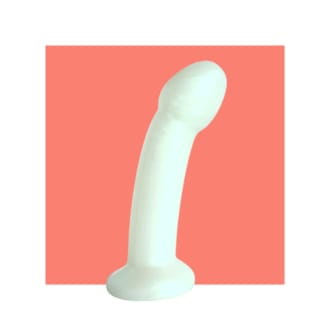 G-spot dildos
G-spot dildos
Designed to stimulate the g-spot, also known as the Gräfenberg Spot, the paraurethral sponge, and the prostata femina (yes, that is a pretty binary term, but we did not invent it!), a g-spot dildo will usually have a curve. This allows the toy to be directed at the so-called “spot” on the front vaginal wall; once you find the area that is especially sensitive to pressure, the curve also allows you to control the amount of pressure you enjoy, add movement, and sometimes even get to orgasm this way. (Some do, some don’t.) The firmer the dildo, the more effective it might be as a g-spot toy.
The g-spot is not a spot at all; it is glandular tissue wrapped around the urethra, and it isn’t even inside the vagina–it is simply easiest to stimulate through the front vaginal wall. Think of its position as roughly on the other side of the clitoris, if you are new to looking for the g-spot. You will almost certainly need lubricant to add to your comfort, since many people need to use a fair amount of pressure to stimulate it. If you’re not aroused, this amount of pressure might not feel erotic (or even enjoyable) to you, so warm up first! And if you don’t actually feel anything, or find what you feel to be especially pleasurable, you can still enjoy using a g-spot dildo much as you would a straighter-shaped one.
Learn more about the g-spot here.
Why it's important to consider the material of your dildo.
The material your dildo is made of affects most aspects of its use–perhaps even the way you store it! It’s especially important when it comes to safety and ease of cleaning; toys made of a porous material can’t ever be completely cleaned after use, and it’s much safer to use a condom with those. (Have a look at this post if you are new to cleaning toys or selecting them with an eye toward how to clean them.)
Material is often associated with how firm the toy is–and many users have strong preferences about this–while it can also affect what the surface feels like, which can very much impact how it feels to use it. This can include how smooth it is (or isn’t), how “natural” it feels (if you are comparing it to flesh), and how much friction you experience from it when you use it. This is affected by how much lube you use, too, and a friction-y dildo might only feel good to some users if they’re using the right lube with it. And speaking of lube, a toy’s material might limit the kinds of lubricant you can use with it, since some materials are potentially damaged by certain types of lube.
Silicone - pros & cons
Silicone dildos are THE most popular category for dildo material at Good Vibes–and many non-rigid dildos are made of it, or a blend of silicone and other materials. Silicone can be quite firm, but never as entirely hard and unbendable as dildos that are made of metal, glass, stone, wood, and acrylic plastics like Lucite®. Silicone is so beloved because it is very easy to clean, warms to body temperature when used, and is flexible to varying degrees–and for every level of softness or hardness in the world of dildos, there are fans of that texture and the way it feels when used. It can also be molded to look all kinds of ways in all kinds of colors, so if you haven’t looked at a dildo since encountering a big ol’ “flesh-colored” (whose?) dong in a porn store, you will be charmed by all the gorgeous colors and fanciful shapes silicone dildos can sport.
The major cons of silicone come into play when you choose a blend (some of the softer toys that are made to feel as much like flesh as possible are not as easy to clean as unblended silicone) and, notoriously, when you choose a lube. Some silicone toys will be damaged by silicone lubricant (though other types of lubes will work well with them).
You can read more about lubes here.
Glass - pros & cons
Glass toys must be made of borosilicate or sodalime glass–materials which resist breakage and aren’t sensitive to fluctuations in temperature. Glass dildos can be stunningly pretty and can be purchased in crystal-clear or colored versions. They are truly the loveliest denizens of Dildo World, plus they’re smooth and sleek, or else made with textures that please some users more than the slippery-smooth ones. Glass toys are not porous, so they’re very easy to clean. Any type of lube can be used with glass.
They are completely inflexible, too–which is a pro or a con, depending. Some users love the hardness of glass and the other rigid materials. Some find it’s too much and don’t prefer it at all. If a glass toy is too cool to the touch, it can be warmed up in a bowl of warm (not hot) water; but there is no way to make it softer, so explore glass with care until you have a sense of how your body responds to it. We wouldn’t necessarily recommend a rigid toy if you like hard and fast thrusting, because something with a little flexibility is likely to be safer for that kind of play.
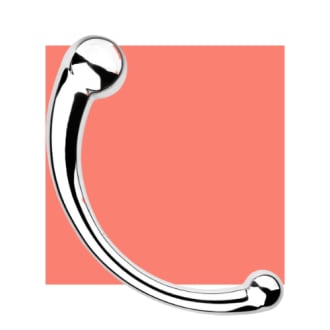 Metal - pros and cons
Metal - pros and cons
Metal–most commonly stainless steel–can also be made into sleek and beautiful toys; many metal dildos look like sculptural works of art. They can be intense to play with, as they have more weight and heft than other materials. Especially for types of penetration play that benefit from pressure–like prostate or g-spot stimulation–they are prized toys. Like glass, you can warm or cool them by putting them into warm or cool water.
Other than the obvious differences between metal and glass, their cons are essentially the same: If a user doesn’t enjoy a rigid, inflexible toy, they will want to take it easy with metal, or not choose it in the first place.
Types of dildos
Note that a dildo might fall into more than one of these categories! And as you explore dildos you may find that your faves always or sometimes mix some of these characteristics.
Hard dildos
We’ve just discussed hard materials like glass and metal, and stone, wood, and acrylic dildos fall into this category as well. In addition to the completely rigid materials, it’s possible to find very firm silicone, though never as hard as metal, glass and the others. Safety note: Rigid dildos aren’t made for strap-on play. For that function, choose a more flexible material, since a hard thrust with a hard toy can be painful or even bruise. Even a very firm silicone will be safer to use than the truly hard types.
If you choose a natural material like stone or wood, make sure your toy is sealed with a body-safe sealant. Without sealant, wood and some types of stone can be porous.
Soft dildos
The title of soft(er) dildos describes quite a range, since really firm silicone can barely be bent to a right angle, while some of the soft blends are extremely squeezable and wiggly. If you can shop at a Good Vibes store, you’ll find each dildo out of its packaging so you can test its density and flexibility for yourself, which is a great way to be sure you’ve found something you like the feel of. Remember that the “realistic-feel” blends will probably be comfortable to use during play but some might be so soft it’s hard to penetrate tight body parts–make sure you choose the right lube if this is what you’re playing with!
 Realistic
Realistic
Realistic dildos are designed to look like penises. They may feel similar, or quite different, depending on their material, but they seek to give the user the sense that they are engaging with a cock. Realistics are also often the top choice of users who want to enhance their own masculine presentation.
Some users will really eroticize these. For others, a realistic dildo would be at odds with their own gender identity or sexual attractions, and there are many other designs–including simple, smooth ones–to choose from. For users who fall somewhere between the poles of this preference there are realistically-shaped dildos in decidedly non-human colors, or blinged up with confetti inside.
Non-representational (funky shapes, unusual shapes, shaped to satisfy kinks)
On the other end of the spectrum from human-esque, penis-resembling dildos, the artistic or kinky designs can be curvy or straight-sided, endowed with texture for a wilder ride, or as fanciful as a Pride flag (the colors, not the shape) or erotically menacing as a werewolf appendage! We assume the latter is making a werewolf fetishist out there very happy.
Vibrating
Vibrating dildos add extra sensation and also are great for strap-on wearers who want some additional stimulation of their own, since most vibrating dildos center the vibes at the base of the toy.
 Double-ended
Double-ended
Most double-ended dildos are longer than average, with a head at each end, and are intended to be used by two people at the same time. This can take a little practice to go smoothly, but these classic toys do have their fans! Note that they are usually too flexible to please both partners (or even stay inside them) unless one of them holds the toy and helps to stabilize and move it. Practice some different positions, you’ve got this!
Strap-on
This term can refer to the unit made up of a dildo plus a harness, or can also mean the dildo itself. A strap-on dildo must have a base that’s large and flat enough to hold the toy steady in the harness; some users find that realistic dildos with balls make that difficult (but some harnesses work better with these than others, so ask us for guidance if that’s what you want to strap on!). Strap-ons are great sex toys for couples, provided they want to explore this way.
Packer dildos (prosthetic dildos to be worn with a harness or jockstrap-like garment)
Packers may or may not be firm enough to use for insertion. They are gender affirmation devices that provide a realistic-looking penis for a person who was not born with one. As such, their wearer might think of them as a sex toy or very much of a different category. But gender affirmation can be central to a person’s ability to have a pleasurable sex life, so we are proud to carry them.
Suction cup
If you choose a dildo with a suction cup at the base it might prove harder to use with a harness, but it’s a great design for sticking onto a hard surface like the wall of the shower, a bench, or the side of a cabinet. This can make for sexy showing off, but also simply give you some stability for your straddle.
How to use a dildo
The basic way to use a dildo is by hand, either on yourself or a partner, for penetration play. This can be vaginal or anal (the latter providing the dildo is anal-safe, with a base to prevent it from slipping inside). Take your time, use lubrication, and find out what you like best–if you have dildos of different sizes, you can start smaller, if you want, and move to the other as you become more aroused and into the sensation.
The not-so-basic way is to use your dildo in a harness for strap-on play. Choose a toy that fits well in the harness you want to wear; make sure that dildo is a pleasing size and shape for any partner you are going to use it with.
Much more about strap-on play here, and here’s an article about pegging – the strap-on play involving a [usually AFAB] partner strapping it on for anal on a [usually AMAB] partner.
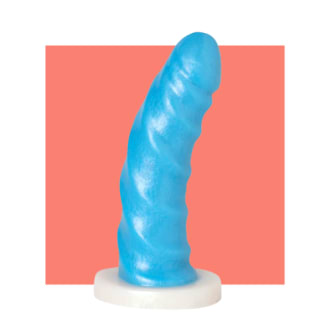 Consent
Consent
Consenting to an activity means you agree to do it, and we should always make sure our partner consents to anything we want to explore sexually. (They may consent to only part of a sexual scenario, in which case you will want to learn about negotiation so you can get on the same page. You’ll also want to make sure you get informed consent–you each understand what you’re going to do and know enough about it to do it safely.) We should add that “not saying no” isn’t the same as saying “oh hell yes,” so when you think about consent, make sure enthusiastic consent is on the table–because that means they want to do the thing!
For that matter, make sure you want to do the thing. Consent goes both/all ways.
When we’re talking dildos, consent could include figuring out what kind of size and shape, as well as actual sexual actions, might be on the table. There might be other things to discuss and negotiate ahead of time too.
Read more about consent here!
Foreplay
Because dildo play generally involves penetration, make sure–just as you would with engaging in intercourse–that you are turned on before the toy nudges into you. If arousal is not high enough, insertion play won’t feel as good as it could. In fact, it might feel neutral–or downright painful. Arousal helps your body get ready for penetration with blood flow to your pleasure parts; this wakes up the nerves that help you process sexual touch as pleasurable, and one reason why some people don’t enjoy intercourse or dildo play is that they are just not turned on enough when penetration starts. So don’t rush! Anything that turns you on–fantasy, erotic media, touch, other toys like vibrators–can be “foreplay” for dildo play. (We put “foreplay in quotes because let’s face it, penetration is not the ONLY sex act! And you don’t have to include it at all, though if you have a dildo, perhaps you want to. All the things that can turn you on, though, are forms of sex play, so don’t discount how important and delightful they can be.)
Texture
If you’ve chosen a toy that’s bumpy or ridged, or has a greater degree of friction than you’re used to, start slow to make sure it’s a comfortable experience. For some, ridged or bumpy toys can cause soreness.
Avoid rough, sharp, scratchy, breakable toys! These are all qualities that can cause harm–and you won’t usually find such toys for sale in sex shops. An older toy might be less safe than it used to be, though–and if you are a “run around the house and find something to use as a dildo” type of person, evaluate your household objects with this in mind, and make sure they’re anal-safe too, if that’s your jam. Better yet, buy a safe toy.
Anal use
Make sure it has a base! Make sure you’ve got lube! Think about safety when you play and you’ll be able to enjoy erotic play for as long as you like.
Cleaning
Keep your dildos clean so you don’t end up with problems like STI transmission (possible if both you and a partner uses the same toy and don’t clean it well enough, IF either of you has an STI). Even when there’s no STI in bed with you, body irritation or pH change can result in problems. Also, just ew! Keep them clean.
Luckily this is very easy with most dildos. If they don’t have a battery or a vibe inside, you can submerge them in water, scrub them with a cloth, use soap or toy cleaner–and if your dildo is silicone, you can even boil it or run it through the dishwasher on the top rack!
When you clean your toy, rinse it off thoroughly. Cleaning agents on mucosa are just about as unsafe as not cleaning your toy to begin with!
Read more about cleaning your toys here.
Sizes of dildos
Here’s some information to help you choose your toy’s size (or to help you decide whether to play with one).
Most importantly–there is NO one agreed-upon and preferred size that pleases everyone. Bigger is not always better, and sometimes people have good reasons to want to start small. No judgment–you respond to the size (and other qualities) of a toy in your own way.
One more thing–many people think of size as equivalent to length. Length is important to many–but girth might be even more important! Both are significant aspects of your dildo that you’ll want to consider.
Finally, the material a toy is made of can affect how large it feels to use. This is particularly true of the rigid materials–because they have no cushion or “give,” these can feel larger than a similarly-sized softer toy might feel.
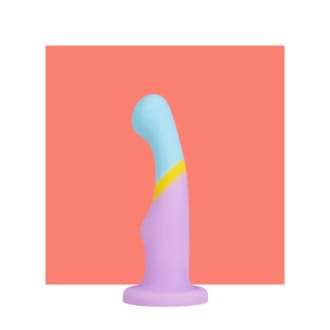 Small dildos - pros and cons
Small dildos - pros and cons
Smaller toys can be shorter than others, as well as more slender. These can be great for beginners, and especially so for those trying to get comfortable with anal play. Smaller toys are appealing to those who are chronically tight, for whom larger toys may cause discomfort; and many penetration fans who have gone through menopause find they are more comfortable with smaller toys because of the changes the vagina goes through after the body’s hormones shift as they do during “the change.”
Interestingly, a short dildo, for some users, is a great length to provide g-spot or prostate stimulation.
Small dildos can be a little more difficult to hold and use, depending on how flexible you are; a shorter dildo can slip out easier than a long one, and this is especially true with strap-ons. Small dildos might not optimally please people who are comfortable with larger toys, penises, and multiple-finger penetration.
Medium dildos - pros and cons
For some, these are the Goldilocks (“just right!”) of dildos. Again, you might find size or girth or both the most significant pleasure element of these. Medium-size toys can activate more stretch receptors than small ones and help us feel pleasurably full without being too much to handle. For some, though, they might still feel too large, or not large enough.
Large dildos - pros & cons
Since the vagina and anus have nerves that carry the message of fullness, some people really love a larger dildo because they eroticize this feeling and are flexible enough not to feel pain with penetration, even with a big toy. Bigger is not better–except to the people who find that it is!
But that isn’t all dildo users. Potential cons: Longer dildos used vaginally are more likely to contact the cervix, which can be sensitive to this (some like it–for others, it feels painful). Girthier ones can be too much, especially for anal. Either in front or in back, the girthier the toy, the more stretch it will require (for some, that’s not comfortable), and the more friction it will cause too. Never force a large, girthy dildo, because this could cause damage.
The importance of lube
Any material a dildo can be made of will have a different degree of friction compared to human skin. It’s always a great idea (and with anal use, a must) to use lube with your dildos, both for comfort and safety. That’s extra-important if your dildo is girthy. Choose the lubricant you like best: More on lube here, and here’s a post specifically about anal lube.
You can apply lube to your dildo and go for it; or you can add some to the body part you are aiming for, or both. Explore a little to see how much lube you like, since too little might still expose you to uncomfortable friction, and too much might impede your pleasure because it’s so slippery. Add more lube when you feel you need it–or, if it’s water-based, just add a few drops of water, which can rehydrate and slick it up again.
Remember to use a lube that’s safe with your toy! So avoid silicone lube with most silicone dildos; if you’ve got a rubber toy, no oil-based lube.
Key lube takeaways:
● Lubricant reduces friction and chance of injury–and the bigger your toy, the more you need lube to do this for you!
● Lube increases stimulation and feels great during all kinds of sex, especially during insertive play.
(We LOVE lube!)
